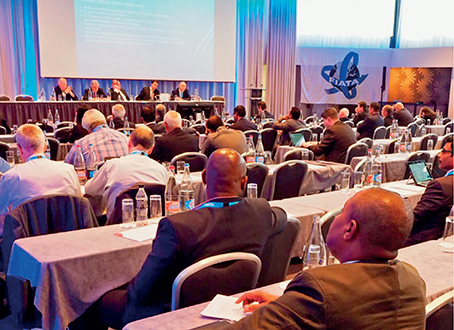INTERVIEW: 50 years on, how do AFI (and FIATA) see the future for freight forwarders?
- News Feed
- Monday, 29 April 2019
 THE AIRFREIGHT Institute (AFI) of the International Federation of Freight Forwarders Associations (FIATA) has reached a milestone – 50 years representing the interests of airfreight forwarders world wide.
THE AIRFREIGHT Institute (AFI) of the International Federation of Freight Forwarders Associations (FIATA) has reached a milestone – 50 years representing the interests of airfreight forwarders world wide.
AFI has come a long way since its founding in 1969 and so has the industry. AFI held its first meeting on 17 June 1970, the same year the B747 ‘Jumbo jet’ made its first commercial flight.
While only 540 747s remain in service today, AFI is still flying high and representing members’ interests.
FIATA president Babar Badat said: “In the past half century, AFI has been following the market development of air freight, addressing its members’ concerns and safeguarding the interests of air forwarders.”
Under the FIATA umbrella are the IATA FIATA Consultative Council, the IATA FIATA Governing Board, ICAO – FIATA DGR Training Program, currently in its eighth year, e-initiatives, safety/security issues, and the IATA FIATA Air Cargo Program (IFACP). The current IATA Cargo
Agency/Intermediary programs will be replaced soon by the new IATA-FIATA Air Cargo Program (IFACP) under the governance of IATA-FIATA Governance Board (IFGB). Once it is implemented, the Cargo Agency/Intermediary Program Rules will be suspended.
Stephen Morris, FIATA acting director general and the chair of AFI Keshav Tanna provided the following perspective on the role of AFI within FIATA and its success in representing its members interests when it comes to air freight.
Over the 50 years of FIATA’s Air Freight Institute (AFI), there have been monumental shifts in freight handling, including the recent introduction of AI and predictive analytics for improved visibility, efficiency and security. How has it affected the role of the forwarder?
One major evolution that we have witnessed over the years is a clear shift in the role of the forwarder from the ‘agent’ of the airline to a ‘customer’ of the airline. This demanded not only a change in commercial dealings but also enhanced responsibilities, as the erstwhile agent now stepped into the shoes of a virtual ‘shipper’.
By doing so, the forwarders took on more accountability in terms of security and transparency of airfreight shipments. The forwarder assumed increased responsibilities not only towards the airlines in terms of security and transparency, but also towards his shippers, who were now his direct customers, rather than that of the airline. Liability regimes changed in such instances, as did the commercials.
What are some of the major achievements of the AFI?
One of the major projects AFI currently is working on is the IATA FIATA Air Cargo Program.
Under the new environment where the agent/forwarder acts as a customer of the airline, it was seen to be appropriate that there be one single Global program, rather than the legacy agency programs which are rather fragmented and governed differently in various parts of the world. This is still under discussion.
How important is reducing shipment idle times?
It is a well known fact that airfreight spends more than 90 per cent of its time on the ground even today.
AFI realises this and advocates to its constituents that digital transformation is one of the best ways to address this anomaly.
The difficulty is that different regions have different challenges and it becomes impossible to adopt a single or common outlook. Some advanced regions are further ahead than others in addressing dwell time issues, but we believe it is only a matter of time before this evolves within all regions as time is of the essence in airfreight.
 What impact has the IoT, with sensors on shipments and so on, had on freight performance?
What impact has the IoT, with sensors on shipments and so on, had on freight performance?
No doubt this is the way of things to come – as mentioned above, transparency and accountability in today’s electronic age is important to all industry partners. Our customers today demand not only performance standards, but also tracking capabilities via access to our internal systems. They insist on knowing the exact position and condition of their shipments from end to end and we are obliged to provide this to them. Technology will continue to be the key driver of the logistics industry and automated processes will play a key role in the supply chain business. The moving parts in the business of logistics are not just the goods, but also the data, which plays a dynamic role in today’s electronic environment.
Cargo distribution processes are moving away from traditional phone and paper procedures. Are changes taking place fast enough?
Not quite. Bookings are on line, AWB execution is on the e-platform for most airlines, tracking and tracing is available on line and many airlines offer rates on line - however, ours is a people business and there’s only so much one can do without a face on the other side – particularly if something goes wrong! E-trade will move ahead, no doubt, but it will definitely not all be about robotics. The human touch will always be important.
How has cybercrime impacted freight delivery and what is being done to combat its growth?
There have been many cyber-related incidents reported in the past five years, with a small number of very high-profile cases within the logistics and freight forwarding sector.
Cyber incidents vary from unsophisticated fraud through ransomware attacks to targeted attacks on specific IT infrastructure. Businesses in the 21st Century are heavily reliant on their IT infrastructure. Many personnel have never known the former manual operation and so are entirely reliant upon the automation and efficiencies that IT infrastructure brings. The logistics and freight forwarding sector is a potentially vulnerable target given its service-based global nature and reliance on IT systems.
Organisations involved in freight delivery should adopt general prevention measures. This can be done by implementing layers of defence, starting with the outermost layer of physical security, followed by management-level procedures and policies, firewalls and architecture, computer policies, account management, security updates and antivirus solutions.
Examples of prevention measures that should be adopted:
• Operating a least-privileged principle, where information and access is limited to a need-to-know basis.
• Employing network-hardening measures, ensuring patch management is adequate and pro-actively reviewed.
• Employing segregation and protocol-aware filtering techniques to protect against cyber threats that might affect critical systems.
• Employing a sound removable device (USBs, laptops) policy with provisions to ensure all USBs are encrypted and tested for viruses prior to being used with other devices.
• Developing business continuity plans, identifying key personnel and establishing processes from both technical and commercial perspectives to prevent the negative impact of a cyber attack from further expanding.
• Organising frequent awareness briefings and training programs to educate all employees on best practice. These can cover installation and maintenance software while avoiding infection and propagation, safeguarding user information and the treatment of cyber physical threats such as the presence of any third party.
• Vetting third-party providers to ensure cyber security compliance.
What is FIATA’s major concern going forward?
We are quite convinced that the forwarder is not really going anywhere, at least in the near future. As mentioned, ours is a people business and our customers wish to speak to us, so there is no real concern in terms of our continued existence. The digital transformation in our industry, however, does pose challenges. We need to keep pace with it, because if we are not geared up, we could lose out.
How do you see air freight growing over the next 50 years?
Airfreight is extremely volatile and a 50-year prediction is out of the question. On the one hand, we see the e-commerce boom and on the other, looming changes through 3D printing, drones and robotics.
The logistics business in the future is going to remind us of the Battle of the Universe in Star Wars – and it will be just as interesting to watch.










